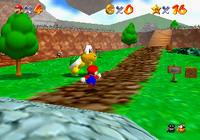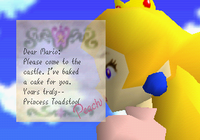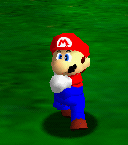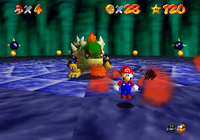Super Mario 64
Template:Infobox Super Mario 64 is a 3D platformer game for the Nintendo 64. It was first released in Japan on June 23, 1996; in the U.S. on September 29, 1996; in Europe on March 1, 1997; and in Australia on March 1, 1997. This game was one of two (three in Japan) launch titles for the Nintendo 64, along with Pilotwings 64, which helped drive initial sales of the console. To this day, it has sold over 11 million copies, the best selling Nintendo 64 game ever. It is also the second most popular game on the Wii's Virtual Console.
Super Mario 64 was originally in development for the Super Famicom, (SNES outside of Japan), but was moved to the Nintendo 64 after system limitations and the ending era of the SNES being close to an end [1]. Though it was not the first 3-D platforming game, it revolutionized the genre, with many games soon following its formula using it as a sort of benchmark[2]. It is widely acclaimed as one of the greatest games of all time[3][4][5].
A version of the game was released in Japan on July 18, 1997, that included Rumble Pak support. This is the same as the International release of the game, as it retains all of the glitch fixes as well as graphical and sound changes (except Mario calling Bowser by his name in a voice clip, which was "buh-bye" in all Japanese versions as he tosses him by the tail - this is because he is not known as Bowser in Japan instead he is known as Koopa). The only differences other than one voice clip are the language being changed back to Japanese and the Rumble Pak support.
A remake of Super Mario 64 was released for the Nintendo DS entitled Super Mario 64 DS in 2004. The remake had various differences from the original game such as Yoshi, Wario, and Luigi becoming as playable characters. There was also a sequel planned called Super Mario 64 2 for the Nintendo 64DD, but became cancelled, due to the 64DD's commercial failure.
Storyline
Princess Peach sent a letter to Mario to come and have some cake with her in the castle. When Mario arrives, he finds one of the Lakitu Bros. who follows him around dangling a camera. Together, they go inside and hear a familiar voice telling them to get out of the castle, actually being Bowser. Toad informs them that Bowser has kidnapped the princess again and is holding everyone hostage inside the castle walls. He has also stole the Power Stars and given them to his minions who are hiding in paintings. Mario hops in the magical paintings and retrieves the Power Stars in order to defeat Bowser and save the Princess.
He then goes through a Bob-omb field where Giant Bob-omb can be found there. Mario's first Power Star lies in this area on where he must collect one before doing all the other Power Stars. Mario then goes through a Whomp infested area where he fights the Whomp King, goes through an icy mountain and many others.
Once Mario collects 70 Power Stars, he can access the door into Bowser's final stage and go through another one of the Koopa King's obstacle courses. Once getting through, Mario finds Bowser waiting for him. The two then begin to engage in battle. Bowser ends up defeated, and is surprised when Mario tells him there were some Power Stars he missed. Bowser gives up, and hands Mario the final Giant Power Star before he disappears. When Mario grabs the last power star, wings appear on his cap, allowing him to fly. He circles the star-shaped arena, and flies away. Eventually, he lands in front of the castle.
As his wings fade away, Mario uses the power of the Giant Power Star to save Princess Peach and take her back at the front of the castle. The star goes into the stained glass window over the front door of the castle, the window flashes, and Peach slowly descends to the ground. Mario rushes up to her as she opens her eyes. Thanking him, Peach kisses Mario on the nose and says she will bake a cake for him. Peach and two nearby Mushroom Retainers walk into the castle. Mario starts to do so himself, but then pauses and turns around to look at the upward. Peach calls his name and Mario runs in after her and the Mushroom Retainers while the camera pans to the left and shows several birds flying through the sky. After the credits scroll, the cake, with Peach and Mario figures, is shown at the very end.
Courses

Levels are laid out inside paintings in the castle, or sometimes the walls themselves. They can also be found in holes, gaps, oil pits, and inside a clock. Each world has seven Power Stars. Within each, one of which is gained by finding one hundred coins in the level. The other six Power Stars are found by performing "missions", fighting bosses, winning races, etc. Every course has boundaries to limit the player from going too far, either as a strict wall or an invisible boundary. If Mario hits either, he falls down (quite often losing a life). Otherwise, Mario is free to roam the large expansive levels at his leisure.
Levels often feature pink Bob-ombs called Bob-omb Buddies. They open cannons littered around the levels for Mario to fly with. When the cannon is open, Mario simply falls into the pit where it is, and it raises. The player targets the cannon with a cross hair shot, and fires. This helps Mario reach high or far away areas. It is often a good idea to use the Wing Cap (see below) with cannons.
- Bob-omb Battlefield
- Whomp's Fortress
- Jolly Roger Bay
- Cool, Cool Mountain
- Big Boo's Haunt
- Hazy Maze Cave
- Lethal Lava Land
- Shifting Sand Land
- Dire, Dire Docks
- Snowman's Land
- Wet-Dry World
- Tall, Tall Mountain
- Tiny-Huge Island
- Tick Tock Clock
- Rainbow Ride
Secret Courses
In addition to the main courses of the game and the Bowser Courses, there are also a few hidden courses that house several of the Castle's Secret Stars, as well as the three ! Switches.
- The Princess's Secret Slide
- Secret Aquarium
- Tower of the Wing Cap
- Vanish Cap Under the Moat
- Cavern of the Metal Cap
- Wing Mario Over the Rainbow
Abilities
In addition to Mario's signature jumping, a whole new host of abilities is given to the player as the game progresses. Mario can punch, kick, kick jump, hip drop (Ground Pound, something Yoshi and Wario could do in previous games), triple jump, long jump, back flip, somersault, and perform the wall kick (bouncing from wall to wall with timed jumps to reach higher areas). The usual Super Mushroom and Fire Flower are absent in this game. Instead Mario gains the power to wear new hats, in the form of colored Caps. The Power Gauge is also introduced, which became standard for future three dimensional Mario games.
The Caps are found inside special '!' blocks littered around the every level. Initially empty, they can be filled by finding '!' switches (similar to the Switch Palaces of Super Mario World). There are three colors to the caps, and each cap lets Mario perform different abilities. It should also be noted that only one form of colored cap can be found in each level. Normally, each cap is worn separately, but Mario can sometimes don two caps at once and combine the abilities of both.
- The Wing Cap (red) allows Mario to transform into Wing Mario and fly around if he performs a triple jump or blasts out of a cannon. This is useful for reaching high or far areas, and finding secrets in the sky. Also, the Wing Cap lets Mario do a Triple Jump without having to walk/run.
- The Vanish Cap (blue) makes Mario transform into Vanish Mario which makes him invulnerable to attacks. He can also walk through some walls to reach new areas, where he can find hidden items or Power Stars. Also, all enemies' attacks travel through him.
- The Metal Cap (green) causes Mario to transform into Metal Mario, which makes him metallic and heavy. This lets Mario defeat enemies by walking into them, walk through streams of fire without taking damage, avoid water currents, and walk under water. Because he is heavy, all Mario can do is walk and jump.
Enemies
Bosses
There are various mini bosses in some stages, but the primary boss is Bowser. He appears three times in three different levels. This is a list of the bosses in the game.
- Big Bob-omb - A giant Bob-omb in Bob-omb Battlefield. He appears as the first star.
- Whomp King - A giant Whomp on top of Whomp's Fortress. He appears as the first star, and after he is defeated, there is a tower on top of the fortress.
- Bowser in the Dark World - Bowser appears at the end of this level. The player needs to swing him by the tail clockwise or counterclockwise and hurl him at bombs on the outside of his circular arena.
- Big Bully - Two of these giant Bullies appear in Lethal Lava Land. On both occasions they try to knock Mario into the lava.
- Eyerok - Two stone hands with eyes on their palms. They appear when the player blasts open the top of the Pyramid in Shifting Sand Land and ride the elevator inside.
- Big Boo - A giant Boo which appears three times in Big Boo's Haunt. He initially appears once all the Boos in the mansion have been removed, again in the underground Merry-Go-Round, and lastly on the top balcony of the mansion (possibly what inspired Boolossus).
- Big Mr. I - A giant Mr. I which only appears in the attic of Big Boo's Haunt.
- Bowser in the Fire Sea - Bowser appears at the end of the level. Game play is the same as the first Bowser, except now his jumps make the arena tilt, causing Mario to need to run up the arena to avoid falling off. Bowser also gains a new move where he vanishes and reappears a short distance away.
- Chill Bully - A large Bully made of ice. He tries to ram Mario onto a lethally frozen pond in Snowman's Land.
- Wiggler - A giant Wiggler, which becomes angry when his home in Tiny-Huge Island gets flooded.
- Bowser in the Sky - Bowser appears at the end of this level. He must be thrown into the bombs three times. Each time he falls off the arena, his jump back makes a piece of the arena fall off. After being hit twice, he stomps the ground and more of the arena will fall off, which then the remaining section of the arena becomes star shaped. Once Bowser gets hit the third time, he will be defeated and leaves behind a giant star, which is not added to the Power Star total after collected. The game will then be completed.
Notable Mistakes and Errors
- When speaking to Yoshi on the castle roof, Yoshi says "Mario!!! It that really you???" instead of "Mario!!! Is that really you???".
- If Mario is one star short of opening a door, it will still refer to the number of stars needed in the plural: "You need 1 stars" instead of "You need 1 star."
References to Other Games
- Super Mario Bros. - A carving of Mario from this game appears on a pillar in Bowser in the Sky. There is also a small jingle used at the Power Star select screen which sounds identical to the first few notes of the opening theme in this game.
- Super Mario World The idea of Switch Palaces is in a way brought back.
- Super Mario World 2: Yoshi's Island - The theme used for invincibility in this game, specifically the string instruments playing in the background, is reworked into Wing/Vanish Mario's theme for Super Mario 64.
- Yoshi's Safari - Yoshi says to Mario that they haven't shared an adventure in ages, and the last adventure they went through together was in this game,
References in Later Games
- Paper Mario - This game starts the same way, with a letter being sent from Peach. Peach's Castle returns and the main room is near identical (however the doors do lead to different rooms).
- Super Mario 64 DS - This game is a remake of Super Mario 64. Also, at the start, Yoshi is on the roof and jumps down, a reference to the fact that he is there at the start of Super Mario 64.
- Mario Kart 64 - Peach's Castle is hidden in the Royal Raceway.
- Super Smash Bros. - Most of Mario's moves and animations in this game are derived from the ones in Super Mario 64. Metal Mario appears as a boss. Two levels based on places here are also accessible, such as Metal Mario's stage and Peach's Castle.
- Mario Kart: Super Circuit - Peach's Castle re-appears in the background of Peach Circuit, Mario Circuit 1 and Mario Circuit 4.
- Mario Kart DS - Tick Tock Clock appears as a race track in this game. Several bosses found here also reappear in this game.
- New Super Mario Bros. - This game uses many things found here, such as Dorrie, and a Bowser head closes in on the screen when the player dies. Some enemies like Moneybags and Scuttle Bugs make their platforming debut. Plus, Wing/Vanish Cap theme is present to Invinciblility theme.
- Paper Mario: The Thousand-Year Door - The game starts in the same way, Peach sends Mario another letter.
- Mario & Luigi: Superstar Saga - In Woohoo Hooniversity, a room with four blocks can be seen in it. One of them is a block from Super Mario 64. The name of the game is even mentioned in the description of the blocks, and the professors are trying to figure out why it vanishes when struck.
- Super Mario Galaxy - The game starts in the same way, with Peach sending Mario another letter. Also, the Bowser level music returns in some of Bowser's galaxies in this game.
- Super Smash Bros. Melee - Two stages based on areas from Super Mario 64 appear: Princess Peach's Castle (which also appears as a trophy) and Rainbow Ride (which also includes a remix of the Super Mario 64 level's music). Metal Mario re-appears as a boss and trophy. Additionally, the Metal Box returns in this game.
- Super Smash Bros. Brawl - Music from Bob-omb Battlefield is unlockable, and the Rainbow Ride stage/music and Metal Box from the previous game returns as well.
- Donkey Kong Country 3: Dixie Kong's Double Trouble! - Wrinkly Kong plays this game sometimes in her Save Caves.
- Super Mario Sunshine - A brief clip of Mario's fight with Bowser is seen when F.L.U.D.D. scans Mario. Also, players can skip the Shine Sprite for the first episode of Bianco Hills, which is a reference to how Mario can frequently get Power Stars which aren't on his current objective in Super Mario 64.
- Mario Power Tennis - The music that plays in the minigame, Artist On the Court has the Peach Castle theme remixed.
- Super Mario Galaxy 2 - In Tall Trunk Galaxy, The Princess's Secret Slide music plays at a moment. Also, the Whomp's Fortress reappears as the Throwback Galaxy, alongside Bob-omb Buddies and the Whomp King. Both games start with Peach sending a letter to Mario.
- New Super Mario Bros. Wii - Peach's Castle reappears in the game, along with its trademark music remixed.
- Mario & Luigi: Partners in Time - The theme that plays in Peach's Castle is a remix version of this game's castle theme.
- Mario & Luigi: Bowser's Inside Story - The music for when the Mario Bros first enter Peach's Castle and when everyone is removed from Bowser's Belly is a remix of the Peach's Castle theme from 64. Also, both games end in a view of a cake with Mario and Peach figures on it.
- Mario Strikers Charged Football - A remix of the music that plays in Big Boo's Merry-Go-Round is featured in this game, as the theme associated with Boo sidekicks.
- Mario & Sonic at the Olympic Winter Games - The Cool, Cool Mountain and Snowman's Land course music is remixed for the Dream Snowball Fight event in this game.
- Super Mario 3D Land - Bob-omb Battlefield was a remixed theme or main theme if you compare closely or listen closely
Media
Official Soundtrack
- Main article: Super Mario 64 Original Soundtrack
An original soundtrack that is based on the game is released. It has thirty-six tracks from the game.
Gallery
Beta elements
- Main article: Super Mario 64/Beta elements
Glitches
- Main article: Super Mario 64/Glitches
Staff
- Main article: Super Mario 64/Staff
Names in Other Languages
Trivia
- When Super Mario 64 was being localized for the English speaking countries, many small changes were made. For example, Princess Toadstool never reads her letter aloud in the Japanese version of Super Mario 64. In 1997, Super Mario 64 was re-released in Japan as "Shindou edition." It featured all the changes from the English game, plus Rumble Pak support.
- In the original (non-Rumble) Japanese version of the game, the portrait for Jolly Roger Bay depicts several bubbles, while the international and Shindou versions show the sunken ship at the bottom of the level. Super Mario 64 DS reverts to the original painting for all regions.
- If a second Nintendo 64 controller is connected to the Nintendo 64, the second player can control the camera while Peach congratulates Mario, as well as during the credits.
- This game is scheduled for display in the The Art of Video Games exhibition of the Smithsonian American Art Museum in 2012.[6]
- The theme of the Boo's Merry-Go Round was used in The Legend of Zelda: Majora's Mask.
References
External links
| Nintendo 64 games | ||
|---|---|---|
| Super Mario franchise | Super Mario 64 (1996) • Mario Kart 64 (1996) • Mario no Photopi (1998) • Mario Party (1998) • Mario Golf (1999) • Mario Artist: Paint Studio* (1999) • Mario Party 2 (1999) • Mario Artist: Talent Studio* (2000) • Mario Artist: Communication Kit* (2000) • Mario Tennis (2000) • Paper Mario (2000) • Mario Artist: Polygon Studio* (2000) • Mario Party 3 (2000) • Dr. Mario 64 (2001) | |
| Donkey Kong franchise | Diddy Kong Racing (1997) • Donkey Kong 64 (1999) | |
| Yoshi franchise | Yoshi's Story (1997) | |
| Crossovers | Super Smash Bros. (1999) | |




